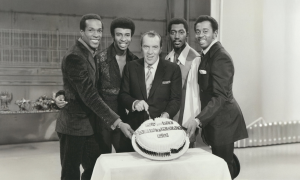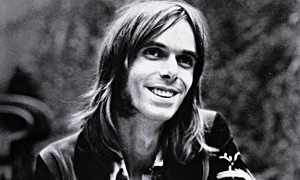Home » Jazz Articles » Film Review » My Name Is Ottilie At The Queen's Film Theatre + Q&A
My Name Is Ottilie At The Queen's Film Theatre + Q&A

In a way, Ottilie Patterson was almost like the Amy Winehouse of her time...
—Dick Taylor, The Pretty Things
Queen's Film Theatre
Belfast, Northern Ireland
January 28, 2023
Most music biopics tell a linear story, chapter by chapter, and then close the book. History as entertainment. The best documentaries, however, act as catalysts, creating a revival of interest in the subject, inviting revisionist histories and even engendering meaningful legacy. My Name Is Ottilie, the moving story of Northern Irish blues and jazz singer Ottilie Patterson, whose star shone brightly in the '50s and '60s, is one of the latter.
Yet despite being a key figure in the British trad-jazz scene that paved the way for the rhythm 'n' blues, beat and blues explosions of the '60s, Ottilie Patterson remains a largely unknown and sadly unheralded figure—a footnote in music history.
There was a time, however, when she was a star. "In a way, Ottilie Patterson was almost like the Amy Winehouse of her time," recalls Dick Taylor, a founding member of rhythm 'n' blues band The Pretty Things. "Everybody would know who she was." Director Diarmuid Lavery's thought-provoking film, which clocks in just shy of an hour, tackles the mystery behind Patterson's uncanny affinity with the blues, her rapid rise to stardom and her equally swift disappearance from the limelight and public life.
Lavery's choice of singer-songwriter Dana Masters as the film's narrator, and our guide in the search to understand Ottilie Patterson's journey, is an inspired one.
The South Carolina-born, Northern Ireland resident—a regular collaborator with Van Morrison—has a deep connection to jazz and blues. Her observation that Patterson sang the blues with "the same sort of weight and passion and authority" as the Afro-American blues legends that lit a fire under her as a young woman growing up in '40s Northern Ireland, establishes Patterson's credentials from the get-go.
More importantly, perhaps, is Masters' intuitive and empathetic handling of the story, which emphasizes Patterson's unique qualities, not just as a singer, but as a trailblazing woman in a male-dominated industry. It was an astute artistic decision on the director's part not to spoon-feed Masters all the facts beforehand, allowing her instead to grapple with the personality, to visit the way stations in Patterson's brief but starry career and to confront some of the more uncomfortable details of her life. The result is a documentary of investigative intrigue and undoubted sincerity.
In 1954, as a 22-year-old jazz aficionado, Patterson went on holiday to London, where, in a Soho basement club, she invited herself to sing as a trad-jazz band was packing up for the night. Impressed, the musicians unpacked their instruments and backed her. For Patterson, it was the dreamlike beginning of what became a successful 10-year stint in trombonist Chris Barber's internationally renowned band.
Patterson's elation at living her dream is clear from audio snippets of interviews. Yet her disembodied voice from a 1990 interview, sounding much older than her 58 years, reveals uncomfortable ghosts. "I just remember the pain, the problems, the trauma."
Patterson's problems, which would manifest themselves in emotional stress, mental illness and an addiction to medication that when combined, doubtless contributed to her demise as a performer, were all tied to her complex relationship with Barber, whom she had married in 1959.
Masters follows in Patterson's footsteps to London, seeking out veteran musicians of the day who offer snatches of insight into her persona and the impact she made on the British music scene. It is hard to reconcile the picture of this joyous young singer, so possessed of inner strength, courage and conviction with the sad figure that she later cut of a woman struggling mentally, fighting depression and slipping from the scene.
In her prime, however, Patterson was something special. "This wasn't just a voice that was good for a small town, or a voice that was good for a small country," Masters observes. "This was a talent that did and could stand on global stages."
At Barber's invitation, a steady stream of American blues legends came to London for the first time in the late '50s and early '60s and performed with the band. Patterson would sing with Big Bill Broonzy, Sonny Terry and Brownie McGhee, Muddy Waters, James Cotton and Sister Rosetta Tharpe, among others. These visiting blues artists and Barber's band, in which Patterson was very much a star, lit the blue touchpaper for a generation of British musicians, many of whom became leading lights of the so-called British Invasion of the United States.
Pianist, bandleader and TV presenter Jools Holland tells Masters that Patterson was ..." a very important stepping stone in the history of British music, in the history of the blues music..."
If there is possibly a single, key reason why Patterson's stellar career unravelled, and why she spent the last 20-odd years of her life living in obscurity in Ayr, Scotland, it comes by way of a shocking revelation, captured in a 1990 interview with Jen Wilson, jazz pianist, founder of Jazz Heritage Wales [and author of Freedom Music: Wales, Emancipation and Jazz 1850-1950 (University of Wales Press, 2019)].
Decades on, Patterson's frail voice holds Wilson and Masters captive as she describes being effectively forced by Barber to have an abortion. The termination took place on Patterson's 24th birthday. She was back at work with the band and touring again two days later. The show, evidently, had to go on, no matter the cost.
In the Q&A that followed the screening , Masters, Joanna Braniff, co-author of How Belfast Got The Blues: A Cultural History Of Popular Music in the 1960s (Intellect Books, 2020) and Charlotte Dryden of Oh Yeah Music Centre, addressed salient themes raised by the film, such as personal agency, mental health, a woman's right to pursue both career and family, plus the historicizing of women's music.
For Braniff, the context of Patterson singing with an electric-guitar-toting Sister Rosetta Tharpe, on a British stage in '50s Britain was "revolutionary."
Refusing to label Patterson as a victim, the panel instead celebrated her bravery, her uniqueness and her historical importance. However, it is hard not to see Patterson's lack of personal freedom, in terms of the coercion surrounding her abortion and in her addiction to, presumably, prescribed medication, in any other terms.
All agreed that Patterson's achievements merit recognition beyond mere documentation. To this end, Braniff was pleased to announce the launch of an Ottilie Patterson bursary for young female musicians, generously supported by Lowden Guitars.
"We wanted this legacy to be a living legacy, because that's what Ottilie would have wanted," Braniff declared. "We wanted Ottilie still to have a positive presence and to be that guiding light for young female musicians. We live in optimism and in hope that that's a role that she will perform for young musicians now."
Tags
PREVIOUS / NEXT
Support All About Jazz
 All About Jazz has been a pillar of jazz since 1995, championing it as an art form and, more importantly, supporting the musicians who make it. Our enduring commitment has made "AAJ" one of the most culturally important websites of its kind, read by hundreds of thousands of fans, musicians and industry figures every month.
All About Jazz has been a pillar of jazz since 1995, championing it as an art form and, more importantly, supporting the musicians who make it. Our enduring commitment has made "AAJ" one of the most culturally important websites of its kind, read by hundreds of thousands of fans, musicians and industry figures every month.

























